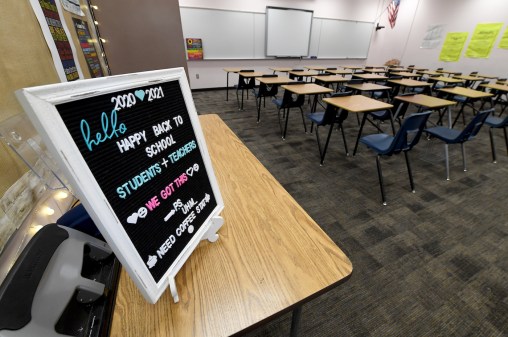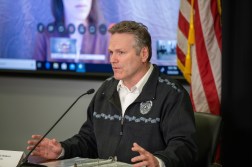Essential elements for building a 1:1 teaching environment

Step 1: Make a plan. That’s the first piece of advice for every superintendent and school leader who asks about creating 1:1 environments in their schools.
During a recent webinar hosted by edWeb.net, presenters said school leaders often miss key steps in their plans to set up a learning environment where each student has a device. The result is not students who ending up with learning devices, but useless hunks of plastic. Led by Ann McMullan, project director for the CoSN Empowered Superintendents Program, the presenters shared their essential elements for a successful 1:1 plan as well as the steps they wish they could redo.
Start with a compelling vision and make it student-centered
Part of the reason most schools switch to 1:1 is because they want the classroom to reflect the real world. Devices like laptops and tablets can be found in many workplaces today. However, the more successful schools focus on improving teaching and learning first with edtech being just one of the tools to support it. This is especially important because the tech will change over the lifecycle of the plan.
Gather stakeholder information every way possible
Use focus groups, the newspaper, town halls, etc. Find out what the parents, students, staff, and community are thinking and help them take ownership of the vision. If the plan begins with wide support and transparency, then schools will have a community dedicated to helping solve issues rather than trying to shut down the initiative.
Allow appropriate time to create tech infrastructure
Moving to a 1:1 environment requires an overhaul of every district building and technology resource. Superintendents fumble when they try to hurry it up and ask their staff to compress it into a few months. The panelists noted that this process can take years.
Make equitable access a priority
Typically, one goal of a 1:1 environment is 24/7 access to learning for both students and teachers. Many students, though, may not have ready access to the internet at home. Schools need to understand their communities’ capabilities and plan for creative ways to provide the same opportunities for all.
Give teachers a head start with the new tech
Whether the school’s tech-savvy teachers have the new tool first or everyone receives it at the same time, the speakers agreed that all teachers need to have the technology in their hands at least six months before the students. This gives them time to familiarize themselves with it, take advantage of professional development, work with their planning teams, and prepare themselves for their new classroom. In addition, inevitably, some staff will leave, and schools should have a plan for onboarding new hires in regard to their technology and learning goals.
Define success and accountability before the plan is implemented
The success of a 1:1 program will look different in every district, and for most the majority of it will have nothing to do with test scores. Determining success factors ahead of implementation and constantly monitoring schools’ progress will allow leaders to make course changes as needed. Sharing the success markers with the school community also creates realistic expectations for the 1:1 program — and gives leaders great talking points when the schools hit the milestones.
From planning for sustainability to developing success markers that don’t just focus on the technology, each presenter identified something they would do differently. Dr. Randy Ziegenfuss, superintendent of Salisbury Township School District in Pennsylvania said if he could go back, in addition to giving teachers time to get on board with the plan, he would involve his principals more.
“Your principals are the people that are key,” he said. “They are on the ground every day with those teachers. This cannot be a central office issue. This cannot be a central office initiative. If it is, it is not going to be successful because your principals aren’t going to know how to support the teachers on a daily basis. You have to make sure that your principals know how to support and are part of the creation of that vision.”
About the presenters
Dr. Peter Aiken is currently the superintendent of Manheim Central School District in Pennsylvania. He is passionate about preparing students for a world that gets crazier by the day. Dr. Aiken began his teaching career in Norfolk, Virginia, as a reading teacher. He returned to Pittsburgh as a high school English teacher. On his way to becoming a superintendent of schools, he has served and garnered tremendous leadership lessons as an assistant principal, principal, and assistant superintendent. Dr. Aiken’s core leadership tenet is everything rises and falls on relationships. Originally from Oakmont, Pennsylvania, a suburb of Pittsburgh, Dr. Aiken now resides in Lancaster, Pennsylvania, with his wife and three kids. He is an avid reader and is often found running and ruminating after a great read. You are invited to connect with him on Twitter and share your favorite leadership book at @pj_aiken. You can also read his leadership blog.
Michelle Murphy is in her second year as superintendent of Rim of the World Unified School District in California. Prior to her appointment as superintendent, Michelle served as the chief technology officer for Coachella Valley Unified School District. During her time with CVUSD, Michelle opened a new department called the “iCenter” which was charged with rolling out 18,000 iPads for the 2013/2014 school year with the focus of supporting nine 900 teachers with the California Computer Science Standards and technology integration/instruction. Michelle is an authorized Apple Foundations Trainer and a CETPA certified CTO. She guided both the educational technology and IT departments to support district and site personnel to plan and complete all iPad deployments and the Mobile Learning Initiative. Michelle’s professional background also includes her tenure at the Hesperia Unified School District as a teacher, assistant principal, principal, and finalist for CA Elementary Principal of the Year.
Dr. Randy Ziegenfuss, Superintendent of Salisbury Township School District in Pennsylvania, is an educational disruption designer. He is passionate about moving K-12 schools away from the dominant “school” paradigm and conversation to a learner-centered, learner-friendly design responsive to the context of the ever-changing, technology-rich world we live in. He strives to answer the question: What new leadership competencies does it take to truly transform our schools — to create a new form of education? You can read his blog and listen to his podcasts, Shift Your Paradigm and TL Talk Radio.
About the Host
Ann McMullan is a 34-year veteran educator who served as the executive director for educational technology in the Klein Independent School District, located just outside Houston, Texas until September 2013, when she and her family moved to Los Angeles, California. For 16 years Ann led the team in Klein ISD that provided professional development on technology and 21st century instructional strategies to over 4,000 professional educators serving over 50,000 students. During that time Ann also co-chaired the Texas Education Technology Advisory Committee which developed the Texas Education Agency’s Long Range Plan for Technology, 2006-2020.
Today, she is based in Los Angeles, California working as a public speaker, writer, and independent education consultant focused on supporting leadership, visioning and planning to meet the needs of today’s students. She is a frequent presenter at state, national and international education conferences. Ann serves as project director for CoSN’s Empowered Superintendents Program. She serves on the board of PowerMyLearning Los Angeles and on the advisory board of Project Tomorrow. In the fall of 2016 Ann co-authored and published Life Lessons in Leadership: The Way of the Wallaby.
Join the Community
Super-Connected is a free professional learning community on edWeb.net for school superintendents, district leadership, and aspiring district leaders.
The edWeb webinar referenced above, sponsored by ClassLink and co-hosted by CoSN, can be found here.




